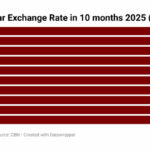
Generation Alpha, or they Fitch Solutions unit BMI said people born between 2010 and 2024 will make up 27% of the Philippine population in 2030, making it a major consumer market.
In an October 27 report, BMI said the Philippines will have the largest population of Gen Alpha consumers in Asia in 2030.
The total population of the Philippines as of July 1, 2024 is 112.73 million.
In India and Indonesia, the proportion of General Alphas in their population will reach 23% by 2030.
Gen alphas will account for 21% of the population of Malaysia and Vietnam in 2030.
In Mainland China, General Alphas will account for 16% of the population in 2030.
On the other hand, Japan and South Korea, which are experiencing low birth rates and aging populations, will have the smallest proportion of Gen Alphas in their population, with 12% and 11% respectively.
BMI said, “Asia will have the largest population of General Alphas in all years, naturally driven by its already large population. In 2030, the General Alpha population in Asia will be approximately 935.7 million, accounting for about 50% of the global General Alpha population.”
It said the Gen Alpha population in Asia is projected to decline to 912.2 million by 2050 as birth rates in China, South Korea and other major markets continue to decline.
Gen Alpha refers to the demographic of the population born between 2010 and 2024. In 2026, they will be between one and 16 years old.
BMI said Gen Alpha will reach two billion by the end of the year, about a quarter or 24.2% of the 8.3 billion global population.
“Generation Alpha already accounts for a quarter of the total world population and as this generation increasingly integrates into the consumer market, consumer trends will align with the preferences of this population,” it said.
BMI said Gen Alphas are rated as “digital natives” because they were born in a highly technologically advanced era and were exposed to technology from an early age.
It says, “The parents of Gen Alphas are primarily Millennials and older Gen Z, whose spending habits and attitudes will lay the foundation for how Gen Alphas will evolve in the market.”
BMI said Gen Alpha will decline to about 20% of the global population by 2050, mainly due to the growing Generation Beta (2025-2039) and Gamma (2040-2054) proportional populations.
Oikonomia Advisory & Research, Inc. Reneel Matt M. Ares, an economist at the Philippines, said in a Viber message that the expected Philippine population growth could be an asset to the country “if properly taken care of.”
“Continued replenishment of the workforce will mean lower dependency ratio, higher productivity and faster growth,” he said.
However, Mr Ares said existing institutions may struggle to adequately address the needs of the growing population if the government does not improve essential sectors such as health care and education.
“Apart from these areas, access to opportunity and income equality remain an issue. These areas must be addressed first to transform population growth from a risk to a strength,” he said. , Katherine K. chan










